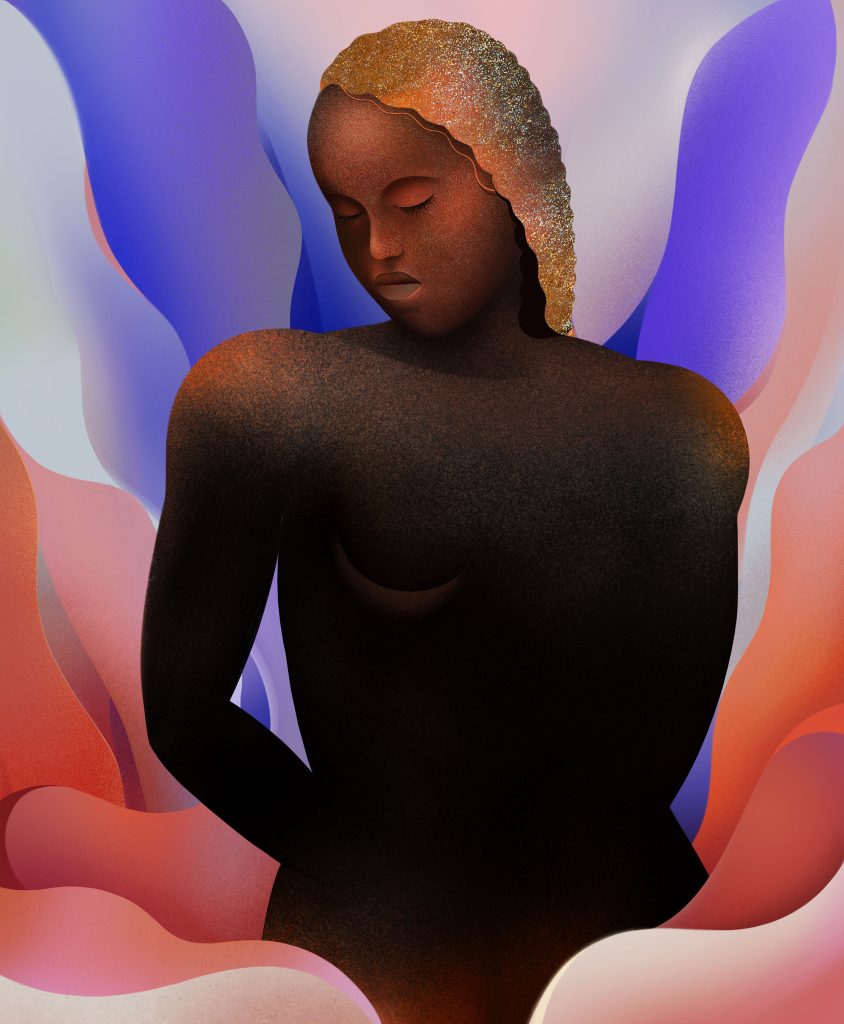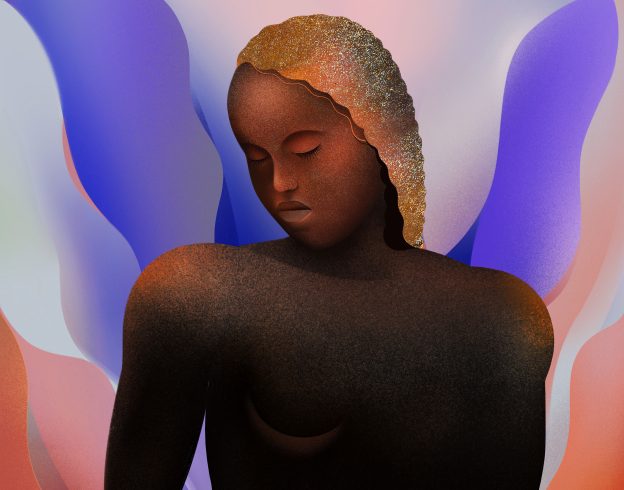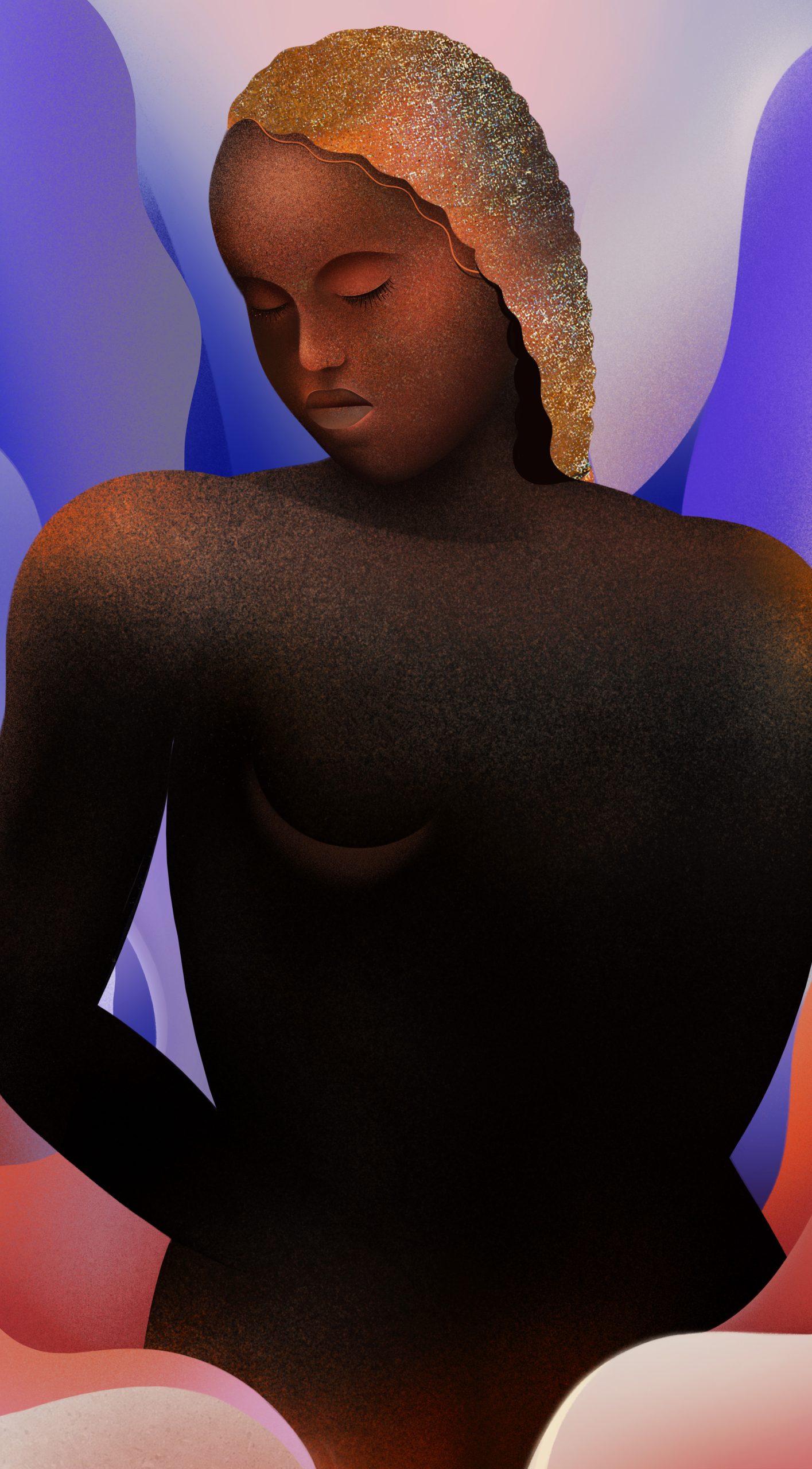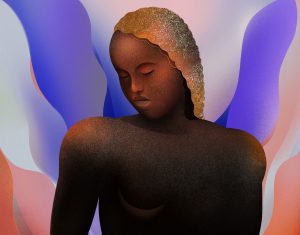with COURS INTÉRIEURES
an artwork by DEBORA CHEYENNE CRUCHON
The moment of orgasm is described as the submersion into an oceanic feeling, a moment of the dissolving of all ego boundaries, including those of gender identities, and the simultaneous merging with the world, a state of cosmic oneness. It is eternal bliss and the ultimate resolution of tension. It is also a state of loss of control, loss of reality, a regression into primary states, and the disappearance of all regulative psychic functions.
And while it seems like accessing that enraptured state is not an issue for the majority of the male population, it is difficult and even impossible for 20% to 40% of women depending on the data consulted—especially those in heterosexual relationships. Ironically, the psychoanalytic project itself emerges with one of the most persistent and bewildering questions on female sexuality: “What do women want?” Now, over a hundred years later, the opacity around female desire is still very dense, and the question of what women want only seems like a continuous iteration of the ‘unknowability,’ the impossibility actually, of any articulation of female desire.
The subject of this work is thus in fact an impossible one, because although the complex of questions in which it moves is anchored in the original moment (perhaps even the reasoning) of psychoanalytic theory itself, that question remains unanswered and continues, through all the schools of thought that have emerged from it. However, the ideas that psychoanalytic theory offers us—but especially the lived reality it aims to explain—are signs that the formulations of psychological processes themselves contribute to the fact that so many women do not orgasm with a partner.
I understand this gap—as well as a large part of the existing theoretical approaches—as a symptom of how discourses on female sexuality have developed historically and socio-politically and are closely interwoven with patriarchal claims to power. These discourses are decisively characterized by simple absence or by the diffusion and mythologization of knowledge, i.e., mechanisms that deny reality. The gendering of Western hegemonic knowledge systems in all its forms is deeply inscribed in the subject’s body and psyche. However, the political and social liberation movements of the last hundred years have still largely failed to penetrate the deeper layers of the bio-political order. Neither have these liberation movements penetrated the individual unconscious that makes it possible for those socialized, identified, and perceived as female to have a sufficiently-occupied inner-psychic space in which autonomous desire can arise and echo, in which active fantasies can safely and playfully develop, an inner-psychic space that enables them to allow the regressive tendencies necessary in the orgastic process, thereby experiencing ecstatic lust and satisfaction.
The International Classification of Diseases (ICD) system classifies this phenomenon under the code “F52—Sexual dysfunction not caused by an organic disorder or disease” in the subcategory “F52.3 Orgasmic disorder.” German sexologist Volkmar Sigusch points out, however, that the last hundred years in particular have shown how unstable and changeable any definition of sexuality is in terms of normality, pathology, perversion, function and dysfunction, as well as the interactions between the appearance of phenomena and their linguistic and cultural classification. The linguistic systems available to us are always limited by the inaccessibility of the unconscious on the one hand, and by their specific incarnation on the other, i.e., the inarticulability of female pleasure is inherent to the logic of phallocentric language. However, I would agree only partially with Luce Irigaray and other feminist theoreticians who postulate that one must create a new vocabulary in order to break away from patriarchal systems of knowledge. Rather than continuing this utopian/idealist effort, I will develop an archaeological and hermeneutical dialogue with existing concepts, in order to reveal that which has been suppressed. Physically and psychologically lived events can never be expressed congruently in language, even newly invented ones. Instead, experiences like orgasm are surrounded by a multitude of processes between which connections can be made, which may possibly produce new patterns of meaning, whatever the terms.
As a diagnosis, the “orgasmic disorder” or “anorgasmia” is one of a variety of so-called ‘sexual dysfunctions’ of the classification systems ICD and the Diagnostic and Statistical Manual of Mental Disorders (DSM-V). In ICD-10 it is described as: “F52.3 Orgasmic Disorder. Info: Orgasm does not occur or occurs with a long delay. Incl: Inhibited Orgasm (Female) (Male), Psychogenic Anorgasmia.” The DSM-V presents the diagnostic criteria gender-specifically and in more detail under code F52.31:
A. Presence of either of the following symptoms and experienced on almost all or all (approximately 75%–100%) occasions of sexual activity (in identified situational contexts or, if generalized, in all contexts):
1. Marked delay in, marked infrequency of, or absence of orgasm.
2. Markedly reduced intensity of orgasmic sensations.
B. The symptoms in Criterion A have persisted for a minimum duration of approximately 6 months.
C. The symptoms in Criterion A cause clinically significant distress in the individual.
D. The sexual dysfunction is not better explained by a nonsexual mental disorder or as a consequence of severe relationship distress (e.g., partner violence) or other significant stressors and is not attributable to the effects of a substance/medication or another medical condition.
Clinicians can also determine whether symptoms are “lifelong, acquired, generalised, situational,” or never occur, and symptoms can also be classified according to severity. All in all, it is extremely difficult to find reliable data on the prevalence of sexual dysfunction, especially female sexual dysfunction. The data identifying female sexual dysfunction ranges wildly, from 5% to 60%. A report from Charité Berlin states that 24.1% of women report orgasm problems, although this figure refers to an outdated American study from 1994.
More recent data, as well as data from Germany, can hardly be found. In a comparable clinical handbook published by Springer Verlag, F. Schneider, and S. Weber-Papen identify the possible difficulties within the data situation. They suggest that research difficulties may result from the “subjectivity of the object of investigation,” under-reporting due to tabooing among doctors and patients (don’t ask, don’t tell), the influence of research methods (possibly from partners, or based on spontaneous information rather than focused surveys) and the instability of survey motivation (whether the study offers treatment options for participants or if it only serves research and marketing interests). In addition, the authors point out that since the introduction of pharmacotherapeutics for the treatment of erectile dysfunction, research interest in male sexuality has been higher.
At this point, however, one could also ask whether research focuses are, in fact, produced by the interests of the pharmaceutical industry, or whether the industry is just capitalizing on the cultural inconceivability of male sexual dysfunction, which is much more problematic than female sexual function in a patriarchal framework based on the fantasy of the potent man. At the same time, it is interesting to note that the most common male sexual dysfunction, ejaculatio praecox, is relatively little-researched, since it does not threaten potency and is therefore apparently not considered problematic.
Firstly, I must admit, that finding any literature on the psychodynamics of female orgasm—inhibited or not—within psychoanalytic theory or the discipline of psychology at large, is very difficult. It has taken me months of research to even get close to resources that don’t exclusively refer to outdated ideas of penis envy and convey a general inferiority of woman—not lastly due to her ‘stunted little clitoris’—or to what are in my view similarly dissatisfying feminist contestations of those claims. Other paths (in my attempt to find more contemporary work) lead to empirical studies on faking orgasm, comparisons between female orgasm and orgasm behavior in rabbits, many studies on orgasms in different relationship modes (such as newlyweds, casual, long-term, etc.), and of course, the universally prescribed remedy: mindfulness. One of the darker paths leads to evolutionary-based psychology, which argues that since the female orgasm is not a prerequisite for procreation, it is just entirely unnecessary.
It is beyond the scope of this project at its current state to generate my own theory of the psychological processes resulting in female orgasm inhibition. Instead, in this essay I examine, analyze, and criticize the fields of psychology and psychoanalysis, which in their pure formation display symptoms of the very issue at hand. The erasures, fallacies, contradictions, and obvious repressions regarding the topic of female sexual pleasure might thus also indicate points of friction, areas of conflict, and especially, make obvious those areas of silence where there should be a lot of noise. What I try to do is, on the one hand, trace the obstacles that have structurally diminished and repressed female sexuality and their effects on psychological processes, and on the other hand, articulate ways that might allow for some liberation from these constraints. The orgasm, though not always at the center of my elaboration, plays the key role of representing the ultimate manifestation of that liberation.
Even though biology is not, in fact, the issue at hand, the body as the primary site of sexual sensations has to be put at the center of this question. In the female sexual body, we enter a highly contested battlefield of blurry boundaries, involuntary access, ownership claims, and unattainable expectations towards shape, size, color, firmness, and hairlessness (the list extends across every inch of skin), resulting in the fact that every girl raised within a heteropatriarchal system comes to meet her own inadequacy at every corner and from a very early age. It’s been a losing game for centuries. But beneath all of this hyper-obsession with all the ways in which a woman should and shouldn’t exist—obsessions that are extremely annoying and take a lot of time and energy to accommodate, unpack, or undo—lies also the issue of a huge (pun intended) lack of knowledge about the basic anatomy and sexual functions of the female body.
And while the penis, with its linear ideology, equals the phallus, which equals power, which is the center of the world—blah blah—talking or thinking about female genitalia already ends at language, not extending to other areas of social organization. Within the last ten to fifteen years we have learned that the term vagina only denotes the birth canal, not the whole organ, for which we need to use the term vulva. The clitoris is a part of the vulva, which—as I heard for the first time at the age of twenty-three, after almost a decade of being sexually active—is not just a little knob somewhere (supposedly hard to find for men) within this wet grove of lips, holes, and flesh, but a gigantic structure that extends on average over twelve centimeters and consists of different cavernous elements stretching throughout the vulva that are all activated when a woman is sexually aroused. Ultimately, this structure is responsible for all types of orgasm that a woman can experience (which I have only learned during this research). Admitting this is also somewhat shameful, but then again, shame is just the intended feminine response, and also, no one ever told me, so how could I know? This knowledge is also still far from being mainstream, it is not easy to access, as there is still a lot of scientific ‘speculation’ on the very mysterious female body.
Even though women and the fantasy/invention of femininity have been controlled by men for centuries, there have also always been rifts and disruptions of that suppression. In the middle ages there were anatomic drawings of the clitoris in its full extent, but, as Anne Zachary points out in The Anatomy of the Clitoris, these drawings were apparently banned. Another eruption appeared in the early twentieth century where, according to Helen O’Connell, a number of displays of the female genital organs disappeared from the standard medical textbook Gray’s Anatomy, as they were considered unnecessary or inappropriate. The relationship between biology and sexuality is not deterministic, but rather unfolds within the meaning that a society at any given time ascribes to either of them. These interpretations then form the ‘realities’ that we live in. This same movement of ‘random’ interpretation for certain fragments and the simultaneous elimination of others can also be observed within the development of psychoanalytic ideas on female sexual organs and their meaning.
Freud described female sexuality as a “dark continent” (i.e., an area yet to be colonized). By using this metaphor, Freud exposes his own enmeshment within a colonial and heteropatriarchal order and the interdependence of these two systems on one another. Freud’s metaphor also indicates one of the larger problems with psychoanalysis: as a theory that is so deeply inscribed with Eurocentric, white patriarchal knowledge, its usefulness and adequacy in the contemporary context must be questioned, along with its foundational concepts—reliant as they are on colonial and heteropatriarchal fantasies—must be challenged.

Within Freud’s elaborations on the question of female pleasure, a central idea that still prevails today is the myth of the vaginal orgasm. Writing in 1905, he wildly postulated that all women who do not experience vaginal orgasm are immature. As proven later, all orgasms are ultimately related to the clitoris, which would then mean that all women (who orgasm) are immature since even vaginal orgasms are clitoral. Through this simple move Freud also casually discredited women’s subject status for their inability to achieve orgasm through an impossible means, imagined to exist by a man. His theory of female sexuality, which he himself admitted was insufficient, was an andromorphic theory of women as deficient beings. Penis envious and castrated, dependent on the man and his phallic supremacy in all areas of life, the woman’s task, then, was to masochistically process this injustice and to accept that she is less and therefore can claim less. She would find satisfaction only in birthing a child, which for her would mean ‘getting’ the phallus (ideally her father’s child). That these ideas are deeply influenced by Freud’s own paternalistic fantasies I will not elaborate further here since this criticism was comprehensively formulated in the feminist psychoanalytical works of the 1970s, for example by Luce Irigaray, Nancy Chodorow, Teresa de Lauretis, Jeannine Chasseguet-Smirgel, and others.
It is not clear to me how psychoanalytic theory has not yet succeeded in developing a more elaborate conception of the psychological processes of female sexual function or their disturbance/inhibition. As Hertha Richter-Appelt describes, while in early psychoanalytic work sexual dysfunction was ascribed with great importance, modern and contemporary psychoanalytic theory lacks a profound examination of the topic. This gap in theory could have to do with the failure, in particular, of Freud’s ideas about female sexuality and the cultural consequences associated with them. Attempts to formulate female sexuality differently have been stifled by this theoretical erasure. One attempt at a new formulation was made by Ines Angermann in 1980. In response to psychoanalytic “stage” theory, she wrote:
Most female sexual dysfunction is said to be due to a disturbed oral phase. There is no satisfying relationship between mother and daughter as there is between mother and son. The resulting frustration is said to cause the girl to remain dependent on her mother in the hope that her unfulfilled wishes will be fulfilled after all. […] It leads to getting stuck in a phase of development in which the primacy of genitality has not yet been reached, so that a variety of sexual disorders can occur. The woman buys the tenderness of her partner by making herself available sexually, although she feels nothing. The woman’s inability to devote herself results from the defence against an intense desire for symbiosis. (translated by AW)
According to this approach, female sexual dysfunction is based on a failed individuation process—the consequence of an unsatisfying relationship between mother and daughter—though the reason for this lack of satisfaction remains unspecified.
Similarly, Dianne Elise traces the central issues of female sexuality back to three major areas of conflict: “female genital image and representation,” “girls’ erotically desirous relationships to their mothers,” and “the nature of women’s experience in adult sexuality.” While the first point refers to the previous argument of anatomy and language in connection with collective cultural fantasies, the second again puts the quality of the mother–daughter relationship in focus, and at fault, for the condition of female sexuality. The presumption of the theory is that the first object of desire—for all children—is the mother as the expected, primary caretaker. Within the heterosexual logic this means that the boy’s desire for the mother is legitimate and will be mirrored (before being prohibited), while the daughter’s desire for her mother is forbidden and thus gets “erased, negated, made invisible, nonexistent.” With her active desire being rejected and devalued, the girl would then feel like she is either unsatisfactory in herself or incapable of satisfying the other. She will, Elise argues, maintain this experience of failure, of not being able to receive that which she wants, within all matters of desire: “In Butler’s terms, the daughter’s desire for the mother is foreclosed in a never-never land of the ‘sexually unperformable’ —a possibility that can no longer be conceived of and thus cannot be grieved.”
The obvious consequence of this argument—if the aim is to empower all kinds of female sexuality, including the ability to achieve orgasm—is that the primacy of heterosexuality within the mother–daughter relationship must dissipate. Mothers can then acknowledge the lesbian aspect of their own inherent bisexuality—a reality of sexuality that Freud himself assumed. In claiming the complexity of her own sexuality, the mother can be receptive to the daughter’s desire for her, and enable the daughter to develop the sense of being able to attract that which she desires. Elise also argues that the oedipal turn to the father as the object–cause of the daughter’s desire could then be seen as a defensive substitution rather than as an actual expression of the multiplicity of desires.
This line of argument poses some interesting models for thinking about what is conveyed in the mother–daughter relationship, especially in the heterosexual family concept, and the conflicts that oftenarise from it. However, this nearly-exclusive focus on the mother–daughter relationship as the source and cause of sexual inhibitions feeds into the already-problematic polarization imposing responsibility and guilt on the mother while the father remains absent and guilt-free. This is the case even though Freud collected a whole number of accounts of his hysteric patients telling him about their perverse and sexually abusive fathers. The focus on the mother–daughter relationship also limits women’s sexual problems solely to the perspective of inner psychological conflicts, when the power relations in society have a massive role in shaping everyday sexual experiences.
Pathways into thinking of less normativizing descriptions of female sexuality and sexual dysfunction (confined to the nuclear family unit) can be found in Britt-Marie Schiller’s more recent critique of models that conceive of the orgasm as a linear concept, in which tension gets built up to a certain point where it cannot be contained anymore, erupts, and ends in conflict-free exhaustion, restoring psychic equilibrium. Linearity often limits perceptions of human reality and the ways in which our bodies and minds communicate, especially as it lacks capacity for what Schiller calls “discontinuous, non-proportional, and unpredictable change or evolution.” And while the linear model might function, though not necessarily sufficiently, to describe the typical process of phallic-male sexuality, it may not work for the physical and psychological processes of sexual experience for women. This is especially true since, often, the female orgasm is not the end of sex in the way the male orgasm usually is, but is rather part of a circular movement that can continue and multiply on different levels of orgasmic experience.
When thinking about the structures of arousal and orgasm, every aspect of discourse can be scrutinized for its implications when it comes to how we conceptualize sexual pleasure. Schiller suggests considering the ideas of chaos theory in order to think about the mechanisms of female sexual function, describing its aims as “effusion and expansion” rather than the “restoration of equilibrium.” As she puts it: “Diffusing and fusing sexuality, and libidinal fluidity, might then be conceptualized as complex dynamic processes, as moving according to labial rhythms.” So possibly, in order for women to become able to “shatter their egos” as Leo Bersani states—that is, to be in a space that resonates with their bodily experience and is safe enough to allow their minds to get lost and fully be in their pleasure—we have to work on expanding our understanding of sexuality altogether, on allowing a female ego into the room, detaching sex from the phallic view of linearity and goal-orientedness, and to instead establish wet, expansive, circular ways of being together.
American Psychiatric Association. Diagnostic and Statistical Manual of Mental Disorders, Fifth Edition. American Psychiatric Publishing, 2013.
Beier, Klaus M., et. al. “Analysis of Health Care in Sexual and Gender Identity Disorders.” Sexuologie, vol. 7, no. 2, 2000, pp. 63-95.
Butler, Judith. Gender Trouble: Feminism and the Subversion of Identity. Routledge, 1995.
Elise, Dianne. “Woman and Desire: Why Women May Not Want to Want.” Studies in Gender and Sexuality, vol. 1, no. 2, 2000, pp. 125-45.
Laplanche, Jean. Life & Death in Psychoanalysis. Johns Hopkins UP, 1976.
Richter-Appelt, Hertha. “Intersexualität.” Bundesgesundheitsbl, vol. 50, 2007, pp. 52–61.
Schiller, Britt-Marie. “Representing Female Desire Within a Labial Framework of Sexuality.” Journal of the American Psychoanalytic Association, vol. 60, no. 6, 2012, pp. 1161-1197.
World Health Organization. ICD-10: International Statistical Classification of Diseases and Related Health Problems. 10th revision, 2nd ed., 2004.
Zachary, Anne. The Anatomy of the Clitoris: Reflections on the Theory of Female Sexuality. Routledge, 2018.
AMELIE WITTENBERG writer
Amelie Wittenberg is currently getting her second degree in Psychology at the International Psycho-analytic University Berlin with a previous degree in Cultural Studies. She is interested in applying interdisciplinary questions on current social issues to the clinical context. She has recently been an intern at Stillpoint Magazine (2020).
Amelie has also produced a Study Resource for Stillpoint Magazine titled “Fantasizing: An Introductory Bibliography on Female Sexuality Through the Patriarchal Unconscious”. You can find it available to download in our Study Room here.
DEBORA CHEYENNE CRUCHON artist
Debora Cheyenne Cruchon is a French multidisciplinary artist based in Los Angeles. After getting a degree in animation from Gobelins, she directed a short film, Couchée, for French television. She currently works as an art director for Buck, while pursuing her own projects in sculpture, painting, and animation. Her work has been exhibited in Leiminspace gallery in Los Angeles and Barney Savage in New York, amongst others. Building a bridge between virtual and physical realities, she explores what lies at the crossroads of opposite worlds, states, and energies, expanding her fascination for what is ever elusive and constantly changing.
Debora was previously featured in Stillpoint Magazine Issue 001: FANTASY here and here.
© Copyright for all texts published in Stillpoint Magazine are held by the authors thereof, and for all visual artworks by the visual artists thereof, effective from the year of publication. Stillpoint Magazine holds copyright to all additional images, branding, design and supplementary texts across stillpointmag.org as well as in additional social media profiles, digital platforms and print materials. All rights reserved.




